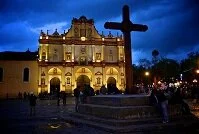
Puerto Vallarta
Due to Spanish colonization and the timing of their colonization, much of Mexico's architecture from the 1600s and 1700s is authentically Baroque (which arrived in the early 1600s). Among Mexico's finest Baroque architecture, the Mexico City Metropolitan Cathedral (1573-1813) and the Sagrario Metropolitano (1749-1768) in Mexico City are perhaps the best examples as these building also inspired later constructions; buildings that were built primarily in the cities of Puebla, Guanajuato, Morelia and of course Mexico city itself.
Mexico City, as the capital of New Spain, received the greatest amount of new architecture under Spanish rule. The city is riddled with thousands of historical monuments, many of which are from this early colonial period and are in the Baroque style, or in a sub-style falling under the larger Baroque definition, like the Churrigueresque Style. However, it is probably the city of Puebla that the style is the most unique as tiles became commonplace and local materials give the buildings a different look from most of Mexico's Baroque architecture.

San Cristobal Cathedral
In about 1780-1800 the Spanish Baroque style ended in Mexico as the Neo-Classical style quickly took over. The School of Mines (1797-1813) in Mexico City and the church, El Carmen (1803-1807) in Celaya are among the most distinct. Like the Baroque style before it, the Neo-Classical style dominated the country through the 1800s.
Although the Neo-Classical style dominated the 1800s, the country was often in political rife and few buildings were constructed during this century. As the century came to a close there were multiple small movements that arose, most commonly in trying to imitate great European cities like Paris. This didn't introduce a new style so much as it introduced random buildings in various styles by numerous European architects. During this time the National Theater of Mexico (1904) and the Postal Palace (1902) were built among others.

Isla Mujeres
In the 1930s the styles from Europe began to decline as domestic (primarily ancient Mayan and Aztec) influences took over, as did influences from other American countries. This happened to coincide with the modern movement as new materials and techniques were introduced, including concrete and glass. Among the local inspirations, most were built as monuments to past leaders of the country. The modern style made the greatest impact on the country's larger cities, including the capital as skyscraper and other modern and post-modern buildings are common place in Mexico City and other large cities.